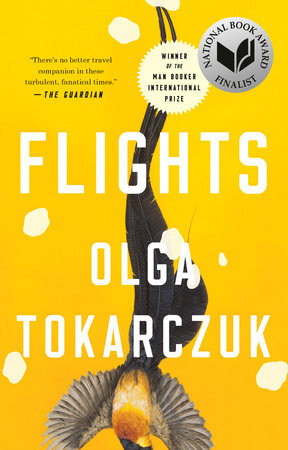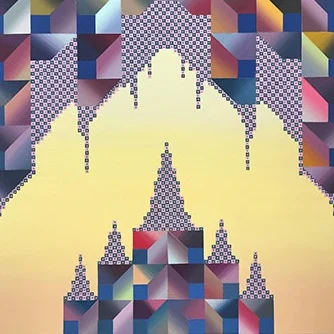Summer Reading List | Aude Jomini
Aude Jomini, Dover Truck-Stop City, a heraldic proposal for the border port of Dover UK (elevation excerpt).
Summer Reading List | Aude Jomini
Summer is lingering in tentative stretches, yet we are undeniably approaching the autumnal equinox. Some of us are more sensitive to these seasonal tides. Plagued by less sunny temperaments, we are bent on intermittent dark thoughts. We begin to feel the tightening grip of approaching gloom. We fear and celebrate the lengthening of night. Its moonlight mystery is rich; its dark thickets are beckoning. We desire the alluring unknown. We prefer to hide from the light, cozying up guiltily in our caves. The books I read this summer have held their sway to this point, but their most haunting features are only beginning to align with this shift. Let the darkness crash down and quiet everything.
Flights
Olga Tokarczuk
With summer travels now over, there are no more fancies left to enable us to run from ourselves. For those of us not ready to re-commit, Olga Tokarczuk’s ever transiting protagonists can lead us on in this series of disconnected tales. Yet her flights do not quite conjure up any utopia of smooth fluidity conquered by a modern cool persona [1]. There lies instead, within each traveler bundled into this non-linear novel, an undeniable void. The meanderings described remain willfully personal, quietly stubborn, secretly directional.
In the beginning, we meet the primary speaker as a mere catalog of disconnected definitions. In lieu of an introduction, she breaks down a deadly list of biological and biochemical statistics:
Hemoglobin: 12.7, leukocytes: 4.5, hematocrits: 41.6, platelets: 228 […] and so on.
Such reductive, pitiless medical truths: they snap like a cold shower in a wry denial of access.
Held somewhere aloft by personal motives shrouded in the loose mystery of partial narration, Tokarczuk’s traveling protagonists are neither on pleasure holidays nor in flight. They are only mundane seekers. They remain untracked. They refuse to dwell in a place, in storytelling, or in memory. Unable to lay down roots, we wander with them in search of meanings. Discovery, like collecting, is akin to a kind of killing. We fear not the irresistible monsters in the curiosity cabinets, but our own sense of ourselves fading within.
The inert objects of Tokarczuk’s morbid desires often become the most substantial linkages in her narrative: embalmed limbs, a father’s stolen body, photographs of sexual organs like pinned insects in cases. Passing along the facts of our obsessions begins to hold more weight than the passing of lives, yet Tokarczuk’s reminds us that “describing is destroying.” To let go of past anchors is the ultimate pursuit, and yet the details somehow seem to carry along, if only as unease—a sense of connections missed, or yet to be fully grasped.
Loose associations of images melt one encounter into another. In this passing, some marks remain. We notice the fickle unreliability of memory. Still restless by nature, we fall into the trap of Dark Patterns. They will keep us circling restlessly around the objects that would ensnare us.
Dark Patterns
Eben Kling and Charli Taylor
Eben Kling and Charli Taylor’s Dark Patterns reminds us that something has gone awry. We are just not ourselves. Where are we? We are explorers, lost deep in the dead-end tunnels of choice architecture. As “users” seeking to understand dark patterns, we are not whole, nor are we wholly the subjects of this book. Like swarms requiring constant re-orientation merely to remain assembled, we must make efforts to suspend ego and forgo any hope of self-realization.
A textual and visual travelogue chronicling several species of devious digital traps, Dark Patterns collapses the devices of economics with our traveling bodies—oft slumping, awkward, unkempt. The book alludes to the fact that we are unwilling participants in hallucinatory subplots of our over-designed systems set loose.
“This is perfect. You are perfect,” Taylor’s text exclaims. Meanwhile, Kling’s graphic alter-egos run amok on interspersed pages, melting into puddles of their own unraveling. We become them. Unwilling to participate wholeheartedly in the theater of either choice or security, we are the wavering and lumpen material witnesses of a cosmology of our own undoing. As fatigue by design induces gentle oblivion, the veil of dark nets holds us together in unexpected ways.
Like malleable sea creatures “trying out all the colors in iridescent fits and starts” [2], our extended bodies, newly threaded with digital tentacles of added functionality, pulsate with unreachable currents and are thus rendered too heavy. Can we not retake control of these magical tricks? Dark patterns are bottomless metaphors—alluring caves open to dangerous exploration. As we set out into the mud of this architecture, we are already remaking it. The effect is of simultaneous connectedness and alienation [2]:
Here I am, all alone, stuck on a piece of this stuff that has come loose.
Black Leopard, Red Wolf
Marlon James
Reading Marlon James’s History of Seven Killings was like witnessing a slow-motion crash in reverse.
I needed to face it and could not tear away. It haunted on for months afterward, so I was eager.
It takes considerable dedication, however, to become remotely accustomed to Black Leopard, Red Wolf’s disturbing and broken tale. The vivid imagery of relentlessly perverse physical action and violence, both perpetrated and received, albeit by man, beasts or indeterminate beings, begins to form deliberate cadences only after dwelling with it –uneasily-- for some time. But like the fluidity of an upsetting nightmare brought on to churn through a temporary inner storm, the allure of James’s language soon becomes a necessary pace of blasphemous incantations.
The gluttonous quality of the text is so appealing: James’s terse words breathe life even into the tale’s most opaque or interrupted set pieces. This is a gluttony of names given or earned. This is a tale for meat-eaters—guilty and joyous alike. Rejoicing in the very glistening reality of flesh is unavoidable. James’s sentences ascend to sensations as the dialogue lingers in repetitions of intense conjuring. The sensory lushness is closely linked to synaesthesia, the hurtling bodily tangle of the action propelled forward merely by the pull of “a nose.”
Oozing anxiety, unfathomable creatures flexibly reorient as intermingled animals or reassemble from mangled, cast-off parts into ethereal presences. The mysterious skins of these unknowable shape-shifters are not loose-fit outlines. The specificity of their components, along with the decided joinery of their spells and charged histories, hangs in the air thick as solids, yielding power to these misfits.
Identity becomes abject hybridity. All eat each other in plain sight. “These are the things that must happen to you.”
Myriad abhorrent characters invade the novel and stick. There is “Bad Ibeji,” an invasive, parasitic malformed twin used as tool of torture; the “Ipundulu,” more a curse than a character as one incarnation is extinguished only to yield another becoming; or the “Bultungi,” a changing hyena “like the head of a dog pushing out the ass of a cat walking backward.”
The constant reshaping is born of necessity: to survive, to fulfill destinies, to avenge grievances. Each transformation remains haunted by a thwarted drive for reinvention and redemption. Lands are rich with limbs and creatures exist as lands themselves, like the wondrous “Chipfalambula”—an island-sized fish that is also a raft.
Obscure maps are richly detailed only to be disrupted by a system of remote interlinked gateways.
The novel’s interconnectedness is so charged with dark turmoil that it willfully destroys any easy immersion. This is one alluring fantasy, but it leads to no possible forms of escapism. That is undeniably one of its most telling successes. Its malleability is neither formless nor without consequence.
As Laboria Cuboniks’s Xenofeminist manifesto proclaims [3]:
We want neither clean hands nor beautiful souls, neither virtue nor terror. We want superior forms of corruption. […] We seize alienation as an impetus to generate new worlds.
It is through, and not despite, our alienated condition that we can free ourselves from the muck of immediacy. Freedom is not a given.
Aude Jomini, Ornament study with hybrid Penrose grid.
Aude Jomini is a Swiss-American artist and designer pursuing collaborative practices and cross-disciplinary projects in art and architecture to foster community. Aude is currently interested in these questions: How can we make ourselves better collaborators? How can we drive new designs to shape a collective future?
Aude recently co-curated the recent exhibition Perverse Furniture with Sarah Fritchey at Artspace New Haven. On the 100th Anniversary of the Bauhaus, the group show explored ramifications of the German school’s principles and utopian philosophies, both in the local urban fabric and through contemporary artworks. The exhibit brought together works that upset conventional or functional notions to send a solicitous message: perverse furniture works against commodity. It is rebellious, dysfunctional, and indeterminate. It posits how cantankerous or willfully out-of-scale objects might provide alternate models of engagement as they beckon unforeseen ways of life.
Other recent projects have also aimed to disrupt the comfort of disciplinary boundaries to create shared experiences. In the pseudo-clinic “A Center for Adult Swaddling,” created for City-Wide Open Studios: Wellbeing in 2018, Aude worked with a team of medical professionals, artists, designers, and researchers to create an immersive participatory installation and public performance about New Haven. In 2017, she co-authored “Upside Down New Haven” with Chen Reichert, a multi-media reimagining of the town Green.
Aude Jomini is currently a Senior Associate at Pelli Clarke Pelli Architects and serves on Artspace New Haven’s Curatorial Advisory Board. She holds a B.F.A. from RISD and an M. Arch. from Yale School of Architecture. Prior to an architectural career, Aude worked as a freelance designer at Printed Matter Inc. and the Brooklyn Museum. She is a founding member of the New Haven feminist collective HeZa.
[1] Helmut Lethen, Cool Conduct: The Culture of Distance in Weimar Germany.
[2] Italo Calvino, At Daybreak.
[3] Laboria Cuboniks, XENOFEMINISM: A Politics for Alienation.
Aude Jomini, Dover Truck-Stop City, a heraldic proposal for the border port of Dover UK (elevation excerpt).









